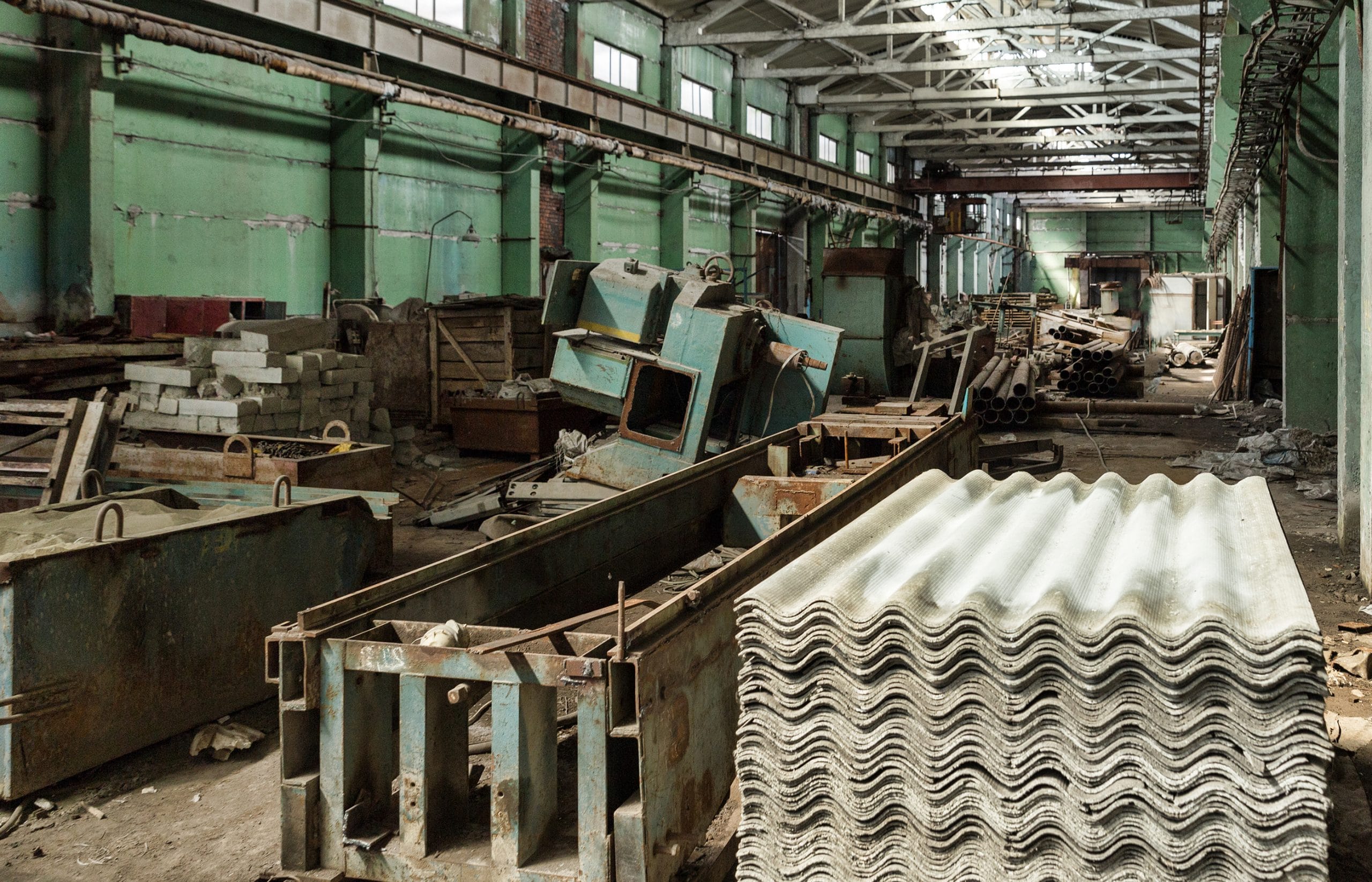Asbestos Manufacturing
Asbestos manufacturing has resulted in the diagnosis of lung cancer, mesothelioma, and other diseases in thousands of former workers and their families.

The History of Asbestos Manufacturing
Asbestos is the generic name representing six fibrous silicate minerals: actinolite, amosite, anthophyllite, chrysotile, crocidolite, and tremolite asbestos. Its fireproof properties have been known to man since 2,000 to 3,000 BCE, yet asbestos wasn’t widely available as a commercial product until the 1800s. In 1879, the first commercial mine opened in Quebec, marking the beginning of the asbestos manufacturing industry.
The following century saw the group of minerals globally mined, manufactured, and used in a massive range of products like paper, cement, brake pads, insulation, vinyl tiles, and more. In many cases, modern uses of asbestos mirrored ancient practices. For instance, in Egypt, cloth-like asbestos was wrapped around the bodies of pharaohs; in 2,500 BCE Finland, asbestos was used to harden clay pots; and it insulated suits of armor in the Middle Ages.
When the first commercial asbestos mining operation opened in the city of Thetford Mines, Quebec, centuries later, it produced over 300 metric tons of asbestos-containing insulation in its first year. Typically, manufacturers used the conventional process of mining and separating ore. Only twenty years later, “curious bodies” in the lungs were described in the first published case of lung scarring caused by being exposed to asbestos. Later, in 1935, the link between the fibrous material and asbestosis and lung cancer was first diagnosed in the U.S. – two years after a confidential settlement between workers and the country’s largest manufacture of asbestos-containing materials (ACM). The effects of asbestos exposure and lung cancer are now well established.
The timeline below gives a glimpse of major events in the history of asbestos manufacturing.
A Brief Timeline of Asbestos Manufacturing

- 2500 BCE: The people of the Lake Juojärvi region in East Finland use the mineral to harden their cooking pots and utensils.
- 13th Century: Marco Polo describes the fiber as a stone (and not the hair of a woolly lizard, as was previously thought) after a visit to China late in the century.
- The 1700s: During the Industrial Revolution, it was used to fireproof new machines like boilers, steam pipes, ovens, and kilns.
- 1879: The commercial asbestos mines in Quebec are the world’s first.
- 1899: First published case of lung disease caused by exposure.
- 1906: In France, after 16 textile workers die of pulmonary fibrosis, workers wear respirators and the plant installs exhaust ventilation.
- 1913: Vermiculite is discovered in Libby, Montana, though it is contaminated with amphibole asbestos. Commercial mining kicks off a decade later and eventually provides 75 percent of all vermiculite.
- 1918: Worry about hazardous exposure to asbestos grows. A report from the U.S. government reveals that insurance companies in America and Canada regularly refused coverage to workers in asbestos manufacturing.
- 1919: A hotel owner in Libby (and part-time miner) experiments with vermiculite and notices its expansion, yet fire-resistance, under a flame. At the time of his death in 1395, his discovery and vermiculite mined from the town are manufactured into thousands of products worldwide.
- 1933: The country’s largest manufacturer of ACM products, Johns-Manville Corp., settles 11 claims from workers that had developed lung diseases. In a paper about employees in the asbestos manufacturing industry released the same year, the author “concludes affected workers face inevitable death” from handling the carcinogen.
- 1934: Another report of workers in the asbestos industry reveals high numbers of lung cancer and asbestosis. Most workers had less than six months of asbestos exposure.
- 1946: An increase in asbestosis diagnoses is found in end-users of asbestos products (i.e., mechanics who install brake pads).
- 1949: Doctors begin to warn that asbestos may be dangerous to the general public as well as manufacturing workers. At the time, more than 200 articles exist about the link between the toxic fiber and disease.
- 1959: After administering x-rays to 130 Zonolite employees, 48 are abnormal.
- 1964: The first warning labels appear on Johns-Manville’s insulation products with ACM. The manufacturer W.R. Grace & Company starts to place employees who’ve reported breathing problems to “less dusty” sections of plants.
- 1970: OSHA (the Occupational Safety and Health Administration) releases the first, federally mandated standards for workers in ACM manufacturing.
- 1975: The Environmental Protection Agency (EPA) bans asbestos from inclusion in thermal insulation commodities.
- 1978: Though the Navy has banned asbestos insulation from the construction of its ships since 1973, it reveals that it has used tons of asbestos in its new ships.
- 1982 -1985: Corporate negligence lawsuits are brought against railroad companies and brake lining manufacturers.
- 1990: W.R. Grace & Co. close its Libby mines.
- 2000: At age 79, the former Chief of Naval Operations Elmo Zumwalt Jr. dies of mesothelioma cancer.
- 2002: The last U.S. producer of asbestos closes due to decreased demand and liability concerns.
Litigation and Regulation
Since the beginning of the 21st century, Congress and several federal agencies have amended old regulations and enacted new protections for workers. Additionally, under the pressure of too many asbestos lawsuits and settlements in 1991, the federal courts consolidated all claims and directed them to a Philadelphia judge.
To cover the legal claims of former employees, over 100 asbestos manufacturers have filed for bankruptcy and created asbestos trusts. In 2011, the Government Accountability Office reported that over 30 billion dollars had been appointed for victims.
In 2018, the EPA decided to expand the legal use of asbestos in the U.S. and will allow the manufacture of asbestos in certain products when granted EPA approval. Known as the April 2019 Final Rule, the new regulation aims to prevent ACM products from returning to the market without evaluation. The EPA claims all products will undergo analyses under the Toxic Substances Control Act section 6.
Asbestos-Related Disease Among Manufacturing Workers
As a friable (i.e., easily crushed and broken up) material, asbestos is often easily ground into dust in manufacturing settings. Next, the dust typically becomes airborne where it can be inhaled or ingested. The amount of exposure generally determines the onset of disease symptoms as well as the severity. Common asbestos-related diseases among manufacturing workers include:
- Asbestosis
- Colon cancer
- Larynx cancer
- Lung cancer
- Mesothelioma
- Rectal cancer
- Stomach cancer
- Testicular cancer
- Throat cancer


